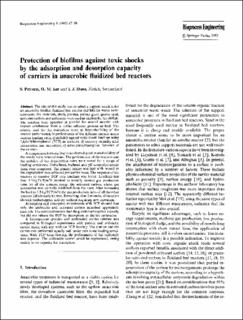Please use this identifier to cite or link to this item:
https://doi.org/10.21256/zhaw-4203| Publication type: | Article in scientific journal |
| Type of review: | Peer review (publication) |
| Title: | Protection of biofilms against toxic shocks by the adsorption and desorption capacity of carriers in anaerobic fluidized bed reactors |
| Authors: | Petrozzi, Sergio Kut, Oemer M. Dunn, Irving J. |
| DOI: | 10.21256/zhaw-4203 10.1007/BF00369032 |
| Published in: | Bioprocess and Biosystems Engineering |
| Volume(Issue): | 9 |
| Issue: | 2-3 |
| Page(s): | 47 |
| Pages to: | 59 |
| Issue Date: | May-1993 |
| Publisher / Ed. Institution: | Springer |
| ISSN: | 1615-7591 1615-7605 |
| Language: | English |
| Subjects: | Activate carbon; Sulfite; Anthracite; Methanogenic activity; Desorption capacity |
| Subject (DDC): | 572: Biochemistry |
| Abstract: | The aim of this study was to select a support medium for an anaerobic biofilm fluidized bed reactor (AFBR) for waste water treatment. Six materials, shale, pumice, porous glass, quartz sand, activated carbon and anthracite were used as carriers for the biofilm. The reactors were operated in parallel for several months with vapour condensate from a sulfite cellulose process as feed. The criteria used for the evaluation were: a) Reproducibility of the reactor performance, b) performance of the different carriers under various loading rates, c) stability against toxic shock loadings using 2,4,6-trichlorophenol (TCP) as toxicant, d) recovery capacity after intoxication and starvation, e) adsorption/desorption behavior of the carriers. A comparison between four runs showed good reproducibility of the steady state removal rates. The performance of the reactors and the stability of the degradation rates were tested for a range of loading conditions. Unbuffered, buffered and pH controlled conditions were compared. The pumice carrier was best with respect to the degradation rate achieved per carrier mass. The response of the reactors to massive TCP step loadings was tested. Loadings less than 1.5 kg TCP/m3d resulted in initially normal gas production rates for all the systems, except the activated carbon, whose gas production was partially inhibited from the start. After increasing the load to 1.5 kg TCP/m3d the gas production rates of all the other reactors fell abruptly to zero. Restarting after 2 months, all reactors showed methanogenic activity without requiring new inoculum. Adsorption and desorption experiments with TCP showed that only the anthracite and activated carbon adsorbed appreciable amounts. The activated carbon had the greatest adsorption capacity but did not release the TCP by desorption, as did the anthracite. A bicomponent (pumice and anthracite) carrier mixture was compared in biological experiments with pumice and anthracite carrier alone, with and without TCP loading. The pumice and the carrier-mix performed equally well under non-toxic-loading conditions. With TCP toxic loading, the performance of the anthracite was superior. The anthracite carrier could be regenerated, owing mainly to its capacity for desorption. |
| Further description: | Erworben im Rahmen der Schweizer Nationallizenzen (http://www.nationallizenzen.ch) |
| URI: | https://digitalcollection.zhaw.ch/handle/11475/3246 |
| Fulltext version: | Published version |
| License (according to publishing contract): | Licence according to publishing contract |
| Departement: | Life Sciences and Facility Management |
| Appears in collections: | Publikationen Life Sciences und Facility Management |
Files in This Item:
| File | Description | Size | Format | |
|---|---|---|---|---|
| 1993_Petrozzi_Protection of biofilms_Biopress and Biosystems Engineering.pdf | 2.41 MB | Adobe PDF |  View/Open |
Show full item record
Petrozzi, S., Kut, O. M., & Dunn, I. J. (1993). Protection of biofilms against toxic shocks by the adsorption and desorption capacity of carriers in anaerobic fluidized bed reactors. Bioprocess and Biosystems Engineering, 9(2-3), 47–59. https://doi.org/10.21256/zhaw-4203
Petrozzi, S., Kut, O.M. and Dunn, I.J. (1993) ‘Protection of biofilms against toxic shocks by the adsorption and desorption capacity of carriers in anaerobic fluidized bed reactors’, Bioprocess and Biosystems Engineering, 9(2-3), pp. 47–59. Available at: https://doi.org/10.21256/zhaw-4203.
S. Petrozzi, O. M. Kut, and I. J. Dunn, “Protection of biofilms against toxic shocks by the adsorption and desorption capacity of carriers in anaerobic fluidized bed reactors,” Bioprocess and Biosystems Engineering, vol. 9, no. 2-3, pp. 47–59, May 1993, doi: 10.21256/zhaw-4203.
PETROZZI, Sergio, Oemer M. KUT und Irving J. DUNN, 1993. Protection of biofilms against toxic shocks by the adsorption and desorption capacity of carriers in anaerobic fluidized bed reactors. Bioprocess and Biosystems Engineering. Mai 1993. Bd. 9, Nr. 2-3, S. 47–59. DOI 10.21256/zhaw-4203
Petrozzi, Sergio, Oemer M. Kut, and Irving J. Dunn. 1993. “Protection of Biofilms against Toxic Shocks by the Adsorption and Desorption Capacity of Carriers in Anaerobic Fluidized Bed Reactors.” Bioprocess and Biosystems Engineering 9 (2-3): 47–59. https://doi.org/10.21256/zhaw-4203.
Petrozzi, Sergio, et al. “Protection of Biofilms against Toxic Shocks by the Adsorption and Desorption Capacity of Carriers in Anaerobic Fluidized Bed Reactors.” Bioprocess and Biosystems Engineering, vol. 9, no. 2-3, May 1993, pp. 47–59, https://doi.org/10.21256/zhaw-4203.
Items in DSpace are protected by copyright, with all rights reserved, unless otherwise indicated.